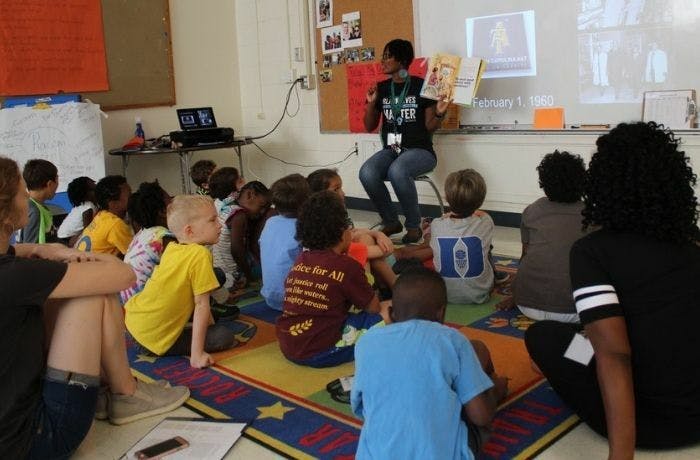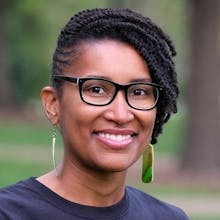Children's Books We Use to Teach Young Kids to be Anti-Racist
By Dr. Ronda Taylor Bullock, Lead Curator for we are

Dr. Ronda Bullock leads a storytime as part of the We Are anti-racist summer camp
Our Durham-based organization, we are (working to extend anti-racism education), has been running anti-racist summer camp programs for early and middle elementary students for four years. What follows is the current list of books we're using (as of October 2020). To learn more about the camp or adult facing trainings we offer, visit us on our site.
For parents/guardians:
- Racism Explained to My Daughter by Tahar Ben Jelloun - Out of their frank discussion comes this book, an international bestseller translated into twenty languages. Ben Jelloun has created a unique and compelling dialogue in which he explains difficult concepts from ghettos and genocide to slavery and anti-Semitism in language we can all understand
For students in Pre-K to Kindergarten
- The Skin You Live In by Michael Tyler and David Lee Csicsko - With the ease and simplicity of a nursery rhyme, this lively story delivers an important message of social acceptance to young readers.
- We’re Different, We’re the Same by Bobbi Kates and Joe Mathieu - Muppets, monsters, and humans compare noses, hair, and skin and realize how different we all are. But as they look
further, they also discover how much we are alike. - Jalani and the Lock by Lorenzo Pace - In this story based on true events, the fictional Jalani, a freed slave, gives the lock that held him in chains to his eldest child as a symbol of his enslavement.
For students in 1st – 2nd grade:
- My Name is Sangoel by Karen Williams and Khadra Mohammed - Sangoel is a refugee. Leaving behind his homeland of Sudan, where his father died in the war, he has little to call his own other than his name, a Dinka name handed down proudly from his father and grandfather before him. When Sangoel and his mother and sister arrive in the United States, everything seems very strange and unlike home.
- Ruby Bridges Goes to School: My True Story by Ruby Bridges - This is the true story of an extraordinary little girl who helped shape our country when she became the first African-American to attend an all-white school in New Orleans.
- Sit-In: How Four Friends Stood Up by Sitting Down by Andrea Davis Pinkney (works for 3rd-5th grade children, too) - A celebration of the 50th anniversary of the momentous Woolworth's lunch counter sit-in, when four college students staged a peaceful protest that became a defining moment in the struggle for racial equality and the growing civil rights movement.
- Si, Se Puede! Yes, We Can!: Janitor Strike in L.A. by Diana Cohn - Carlitos' mother is a janitor. Every night, he sleeps while his mother cleans in one of the skyscrapers in downtown L.A. When she comes home, she waves Carlitos off to school before she goes to sleep. One night, his mamá explains that she can't make enough money to support him and his abuelita the way they need unless she makes more money as a janitor. She and the other janitors have decided to go on strike.
- The Name Jar by Yangsook Choi - Being the new kid in school is hard enough, but what about when nobody can pronounce your name?
- I Am Mixed by Garcelle Beauvais - Jay and Nia are the children of two worlds, and as they'll discover, they can enjoy the best of both.
- All the Colors We Are by Katie Kissinger - This bilingual (English/Spanish) book offers children a simple, scientifically accurate explanation about how our skin color is determined by our ancestors, the sun, and melanin.
- These Hands by Margaret H. Mason - In this powerful intergenerational story, Joseph learns that people joined their hands together to fight discrimination so that one day, their hands--Joseph's hands--could do anything at all in this whole wide world.
- Amazing Grace by Mary Hoffman - Grace loves stories, whether they're from books, movies, or the kind her grandmother tells. So when she gets a chance to play a part in Peter Pan, she knows exactly who she wants to be.
- The Streets are Free by Kurusa - This inspiring book is based on the true story of the children of the barrio of San Jose de la Urbina in Caracas, Venezuela. There are no parks where they live, and the children must play in the streets.
- I’m New Here by Anne Sibley O’Brian - Young readers from all backgrounds will appreciate this touching story about the assimilation of three immigrant students in a supportive school community.
- The Youngest Marcher: The story of Audrey Faye Hendricks, a Young Civil Rights Activist by Cynthia Levinson - Meet the youngest known child to be arrested for a civil rights protest in Birmingham, Alabama, 1963, in this moving picture book that proves you're never too little to make a difference.
- My Name Is Jorge: On Both Sides of the River by Jane Medina - Jorge is trying to learn the ways of his new country. He wants to fit in at school, but he doesn't want to forget his homeland, Mexico. His family is still doing things like they're in the old country, but Jorge wants to find out everything he can about his new country--on the other side of the river.
- Teach Us Your Name by Huda Essa - This fun yet meaningful story was created to empower children to teach others how to pronounce their names correctly.
- IntersectionAllies: We Make Room for All by LaToya Council & Carolyn Choi - A welcoming resource for conversations about equality and social justice that shows readers how identities are made up of myriad influences.
For students in 3rd-5th grade:
- Ruth and the Green Book by Calvin Alexander Ramsey - Ruth's story is fiction, but The Green Book and its role in helping a generation of African American travelers avoid some of the indignities of Jim Crow are historical fact.
- Malcolm Little: The Boy Who Grew Up to Become Malcolm X by Ilyasah Shabazz - Malcolm X grew to be one of America's most influential figures. But first, he was a boy named Malcolm Little.
- Freedom on the Menu: The Greensboro Sit-ins by Carole Boston Weatherford - There were signs all throughout town telling eight-year-old Connie where she could and could not go. But when Connie sees four young men take a stand for equal rights at a Woolworthas lunch counter in Greensboro, North Carolina, she realizes that things may soon change.
- We are Like the Clouds by Jorge Argueta and Alfonso Ruano - Why are young people leaving their country to walk to the United States to seek a new, safe home? Over 100,000 such children have left Central America. This book of poetry helps us to understand why and what it is like to be them.
- Let’s Talk About Race by Julius Lester** - This stunning picture book introduces race as just one of many chapters in a person's story.
- Remember: The Journey to School Integration by Toni Morrison - Morrison has collected a treasure chest of archival photographs that depict the historical events surrounding school desegregation.
- Something Happened in Our Town by Ann Hazzard, Marianne Celano, and Marietta Collins - This book follows two families -- one White, one Black -- as they discuss a police shooting of a Black man in their community. The story aims to answer children's questions about such traumatic events, and to help children identify and counter racial injustice in their own lives.
- Separate is Never Equal by Duncan Tonatiuh - When her family moved to the town of Westminster, California, young Sylvia Mendez was excited about enrolling in her neighborhood school. But she and her brothers were turned away and told they had to attend the Mexican school instead.
- The Streets are Free by Kurusa - This inspiring book is based on the true story of the children of the barrio of San Jose de la Urbina in Caracas, Venezuela. There are no parks where they live, and the children must play in the streets.
- Malala, a Brave Girl from Pakistan/Iqbal, a Brave Boy from Pakistan: Two Stories of Bravery by Jeanette Winter - One country: Pakistan. Two children: Iqbal Masih and Malala Yousafzai. Each was unafraid to speak out.
- Xochitl and the Flowers by Jorge Argueta - A tender, poetic, and moving story about a family's determination to set down roots and about their child's blooming among friends and neighbors.
- Malala’s Magic Pencil by Malala Yousafzai - As a child in Pakistan, Malala made a wish for a magic pencil. She would use it to make everyone happy, to erase the smell of garbage from her city, to sleep an extra hour in the morning. But as she grew older, Malala saw that there were more important things to wish for. She saw a world that needed fixing.
- The Day You Begin by Jacqueline Woodson - There are many reasons to feel different. Maybe it's how you look or talk, or where you're from; maybe it's what you eat, or something just as random. It's not easy to take those first steps into a place where nobody really knows you yet, but somehow you do it.
- Undocumented: A Worker’s Fight by Duncan Tonatiuh - The story of immigrant workers who have come to the United States without papers. Every day, these men and women join the work force and contribute positively to society.
- Marley Dias Gets It Done: And So Can You! By Marley Dias - Marley Dias, the powerhouse girl-wonder who started the #1000blackgirlbooks campaign, speaks to kids about her passion for making our world a better place, and how to make their dreams come true!
- This Book is Anti-Racist: 20 Lessons on How to Wake Up, Take Action, and Do the Work by Tiffany Jewell - Learn about social identities, the history of racism and resistance against it, and how you can use your anti-racist lens and voice to move the world toward equity and liberation.
- Mama's Nightingale: A Story of Immigration and Separation by Edwidge Danticat - This tender tale shows the human side of immigration and imprisonment--and shows how every child has the power to make a difference.
** Choosing books that teach about race in a way that children can learn is difficult. We like Let’s Talk About Race for the explicit ways it helps children to think about skin color. However, we do not agree with the “colorblind” language used at the end of the book. We want to see & appreciate our racial differences, not remove them. We address this with students. No book is perfect, and this one makes for great discussion.

Ronda Taylor Bullock
Get Insights In your Inbox
Join the EmbraceRace community! You will receive the newsletter with our latest on race & kids, including upcoming events and opportunities, resources, community news and curated links.
Subscribe


